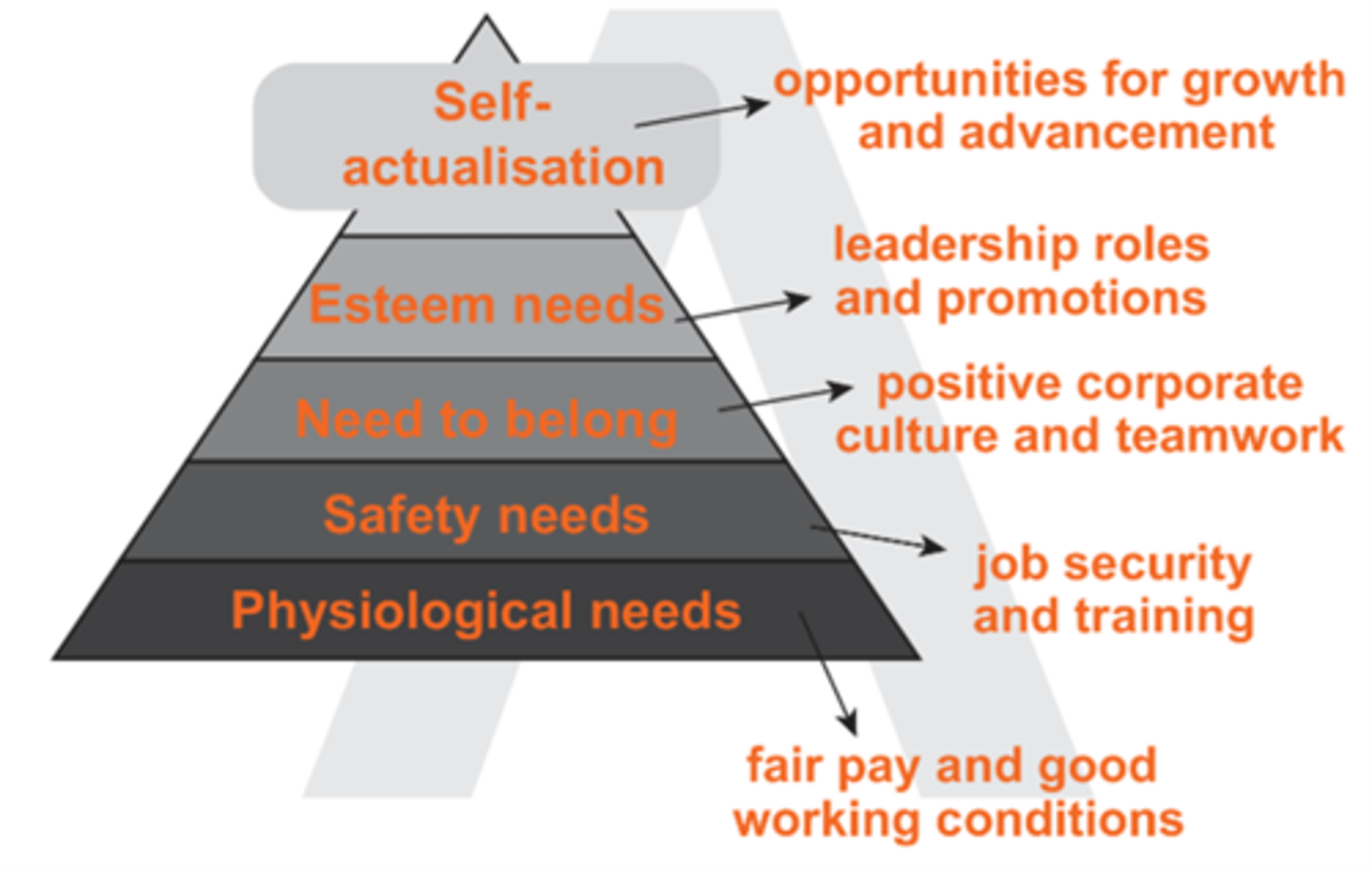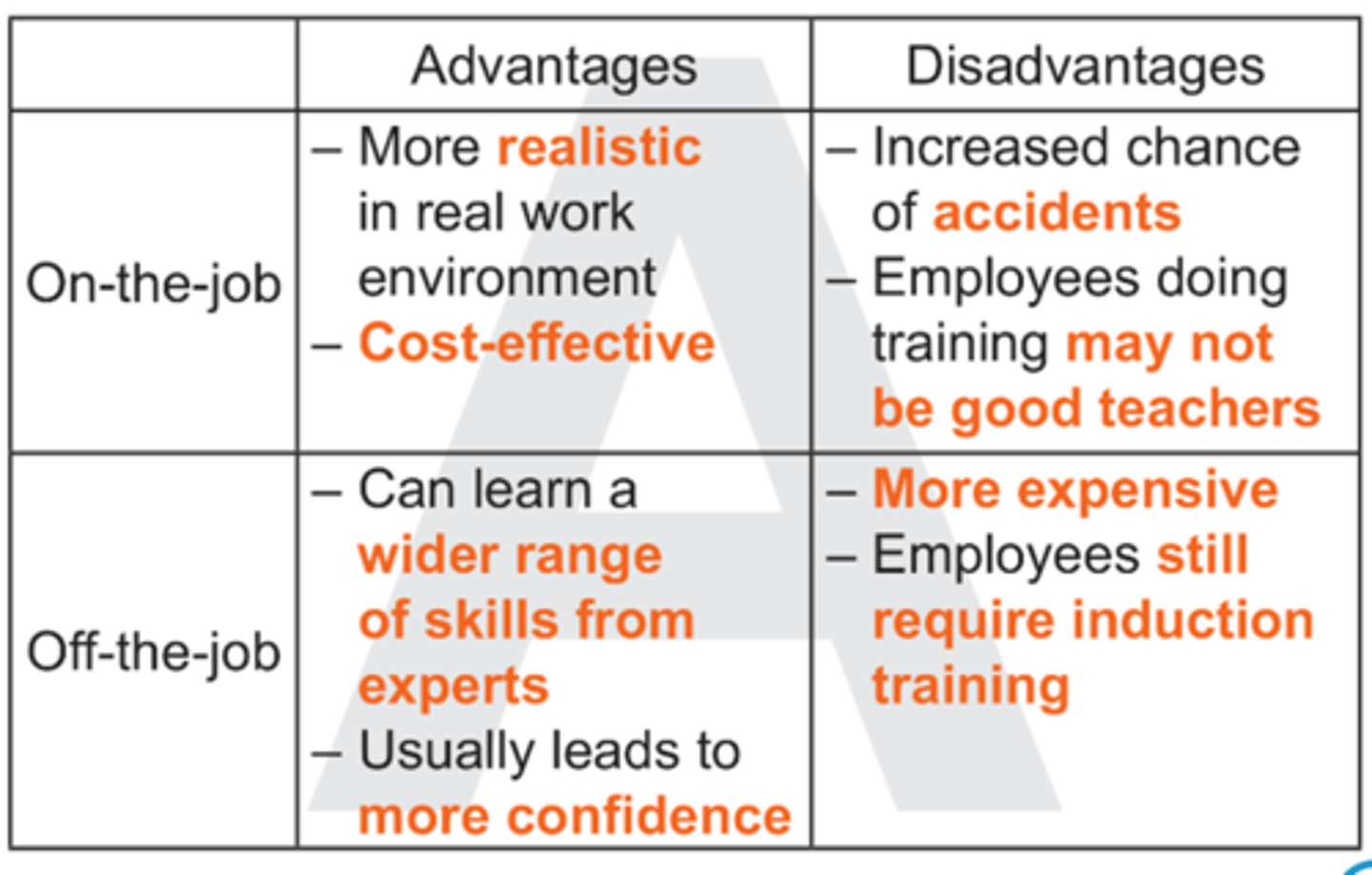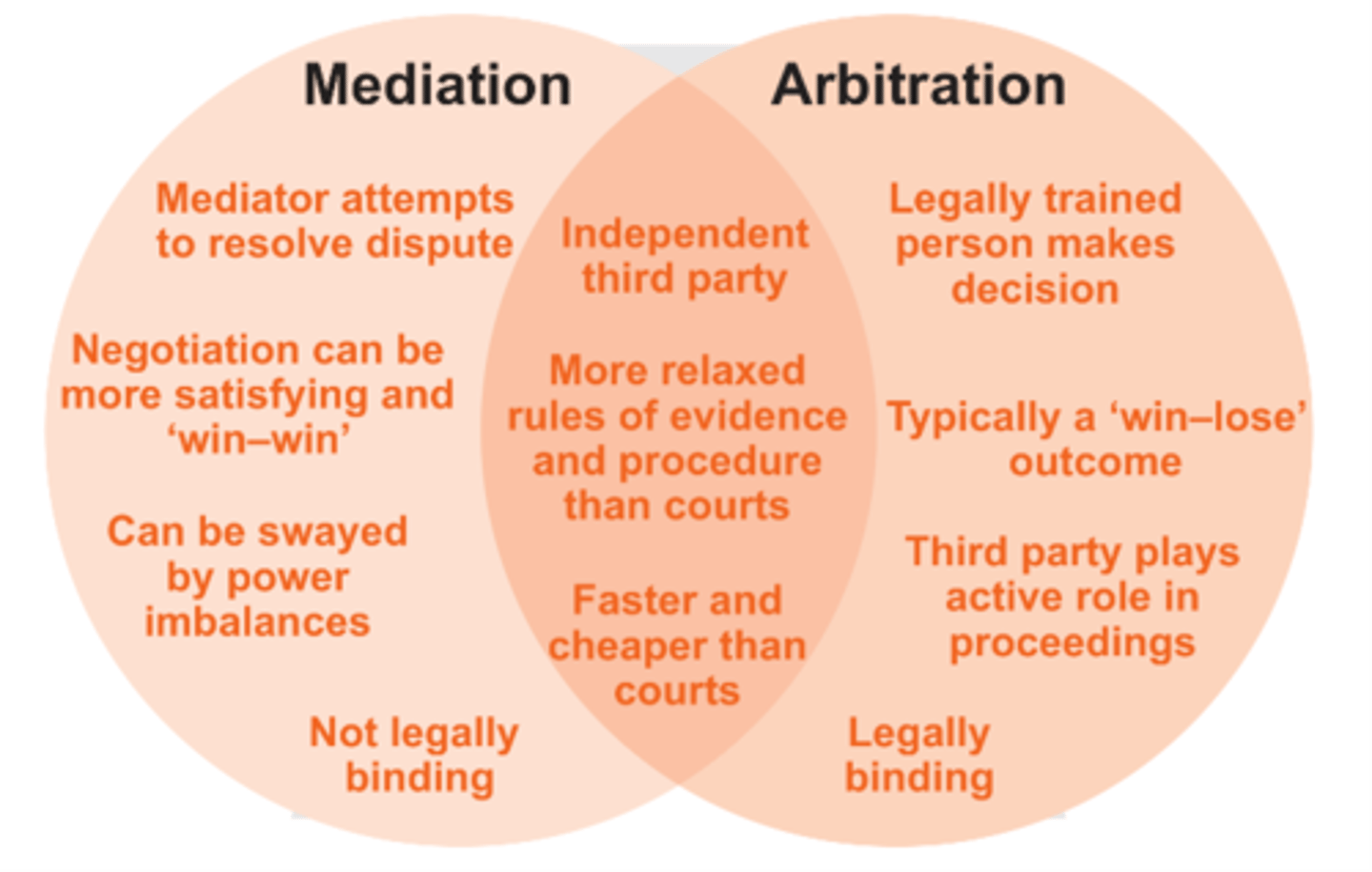Bus Man SAC 2
1/88
There's no tags or description
Looks like no tags are added yet.
Name | Mastery | Learn | Test | Matching | Spaced |
|---|
No study sessions yet.
89 Terms
How can HR management help meet business objectives?
HR management ensures staff are appropriately trained and motivated to pursue objectives for the business
e.g. good training and regular performance appraisals
better customer service
more profits
What are the 5 levels in Maslow’s Hierarchy of Needs, and how can a business support each one?

What are the requirements for motivating goals according to Locke and Latham’s Goal Setting Theory?
· Specific, clear, and explicit
(e.g. ‘increase sales by 5% this quarter’)
· Challenging but not overwhelming
(e.g. increase sales by 5% not %500!)
· Set up by employees and employers together
(i.e. not determined autocratically with no employee input)
· Accompanied by advice and feedback from management
(i.e. ongoing support and recognition of achievement)
What are the components of Lawrence and Nohria’s Four Drive Theory, and how can each of them be met by a business?
1. Acquire: drive to obtain material goods/status met through performance-based promotions
2. Bond: drive to connect with others, met through good interpersonal management and fostering positive employee relationships
3. Learn: drive to become more skilled, smart or creative, met through varied, challenging opportunities and rewarding upskilling
4. Defend: drive to protect self/others from threats or change, met by maintaining supporting environment and open communication
Name the 5 motivation strategies and explain their long-term positive effects.
1. Performance related pay: drive to obtain material goods/status met through performance-based promotions
2. Career advancement: drive to connect with others, met through good interpersonal management and fostering positive employee relationships
3. Investment in training: drive to become more skilled, smart or creative, met through varied, challenging opportunities and rewarding upskilling
4. Support strategies: drive to protect self/others from threats or change, met by maintaining supporting environment and open communication
Evaluate on-the-job and off-the-job training options.

What are the 4 performance management strategies that HR managers can use?
1. Management by objectives: create, agree to, and monitor goals with employees
2. Appraisals: formal assessment of performance to give feedback and identify areas of improvement
3. Self-evaluation: employee rates their performance to compare with manager’s assessment
4. Employee observation: manager discreetly watches employee’s work habits
What are the different types of voluntary and involuntary termination?
Voluntary: retirement, resignation, nomination (e.g. if business is downsizing, an employee may volunteer)
Involuntary: dismissal, redundancy
How does the role of unions differ from that of HR managers in the workplace?
Unions = represent employees, campaigning on their behalf for better conditions and pay, ensuring employers abide by agreements
HR managers = represent the business, negotiating disputes and agreements between employees and employers
What requirement do awards and workplace agreements have to adhere to?
· Must meet the 10 National Employment Standards set by the Fair Work Act 2009
· Must pass the no disadvantage test
· Negotiations must be in good faith
What is the difference between industry-wide awards, collective agreements, and individual contracts?
Industry-wide awards = legally enforceable conditions of employment (e.g. pay, length of shifts)
Collective agreements = negotiation between employees/unions and an employer
Individual contracts = agreement between an employer and a single employee
Compare and contrast mediation and arbitration as dispute resolution methods.

Management structure
A term used to describe the ways in which parts of an organisation are formally arranged in order to achieve objectives.
Management hierarchy
An arrangement that provides increasing levels of authority at higher levels of the hierarchy.
Chain of command
A feature of the management hierarchy that determines responsibility, supervision, and accountability of members of the organisation.
Division of labour
Refers to the way tasks and duties are set out in an organisation - more centralised structures have highly specialised divisions of labour.
Performance related pay
An employer can provide motivation to their staff with direct payments, such as pay increases, bonuses, and commissions, based on how well they perform their duties in the business.
Career advancement
This is the use of promotions in order to motivate staff within an organisation
Sanction
This is a negative motivation technique which involves disciplining staff about what they have done incorrectly in order to attempt to ensure that they perform their job at a higher level in the future.
retirement
Occurs when someone takes themselves out of the workforce entirely, and is a voluntary method of termination.
redundancy
Occurs when a person's job no longer exists, usually due to technological changes, or a merger between two companies.
resignation
This is a voluntary method of termination where the employee leaves the business, normally to take a different job at another company.
dismissal
Occurs when the behaviour of an employee is unacceptable and the business terminates their employment.
mediation
Is the confidential discussion of issues with the assistance of an unbiased third party to attempt to come to a mutually beneficial resolution of the issue; the outcome is not legally binding.
arbitration
Is a process where a 'judge' hears both parties' arguments in a dispute in a more formal setting, and determines a legally binding outcome.
Maslow’s Hierarchy of Needs
is a psychological theory that categorizes human needs into a five-tier model, typically represented as a pyramid, with basic needs at the bottom and self-actualization at the top.
Hierarchy of needs- strengths and weaknesses
Strengths: - allows management to understand employee individual needs. - allows management to be aware of employees at different levels. - easy to understand and implement.
Weaknesses: - the stages may not apply to all individuals. - A manager using the theory may struggle to categorise some employees. - method of motivation may not be effective
Locke and Latham Goal setting theory
a motivation theory that states the employees are motivated by clearly defined goals that fulfill five key principles.
Key principle of goal setting theory- Clarity
Goal needs to be clear and specific so that employees know exactly what is expected of them.
Key principle of goal setting theory- Challenge
Goals should be challenging yet achievable, pushing employees to perform at their best without causing undue stress.
Key principle of goal setting theory- commitment
Employees must be committed to achieving the goals, which increases their motivation and enhances performance.
Key principle of goal setting theory- Feedback
Regular feedback on progress helps employees understand how well they are doing and what adjustments may be needed to stay on track towards achieving their goals.
Key principle of goal setting theory- task complexity
Tasks should be appropriately complex, taking into account the abilities of the employees to ensure they can engage and succeed without becoming overwhelmed.
Goal setting theory- strengths and weaknesses
Strengths: - motivate employees, improve performance, increased productivity
Weaknesses- too vague goals can lead to poor performance, goals that aren’t challenging can be demotivation, employees may ignore other responsibilities.
Lawrence and Nohria’s Four Drive Theory- Drive to Acquire
includes the desire to own material goods and encompasses the desire for status, power and influence.
Workplace applications: remuneration should be comparable with competitors, tying monetary rewards to improvements, providing opportunities.
Lawrence and Nohria’s Four Drive Theory- Drive to Bond
includes the strong need to form relationships with other individuals and groups.
Workplace applications: fostering teamwork, creating a collaborative environment, and encouraging social interactions among employees.
Lawrence and Nohria’s Four Drive Theory- Drive to Learn
include the need to understand the world around us, to be challenged mentally and be faced with interesting experiences.
Workplace applications: providing opportunities for personal and professional development, offering training programs, and encouraging innovative thinking and problem-solving.
Lawrence and Nohria’s Four Drive Theory- Drive to Defend
the desire to remove threats to our safety and security and to protect what we regard as ‘ours’
Workplace applications: all employees treated with respect, rewards are fair, managers foster an atmosphere of trust, employees encouraged to speak up
Lawrence and Nohria’s Four Drive Theory- Strengths and weaknesses
Strengths: encourages independence, flexibility, improves behaviour thereby improving performance
Weaknesses: other drives may exist, could foster competition between employees.
human resource manager
coordinates all the activities involved in acquiring, developing, maintaining and terminating employees from a business’ human resources
motivation
refers to the individual, internal process that directs, energises and sustains a persons behaviour
human resource management
the effective management of the formal relationship between the employer and employees
productivity
a measure of performance that indicates how many inputs (resources) it takes to produce an output (goods or services)
need
a personal requirement
Hierarchy of Needs
Maslow’s sequence of human needs in the order of their importance
extrinsic rewards
a tangible or physical reward given to someone for achieving something
intrinsic rewards
an intangible reward that comes from within the person achieving success such as a sense of satisfaction or fulfillment
motivation strategies: performance related pay
the monetary compensation provided to employees relative to how their performance is assessed according to set standards
motivation strategies: career advancement
the assignment of more responsibilities/authority to employees or the promotion of employees to positions that bring rewards, such as increased salary, fringe benefits and increased responsibilities.
motivation strategies: investment in training
the direction of finances, or resources such as time, into the teaching of skills to employees
motivation strategies: support
the assistance or services provided by the business to help employees cope with difficulties that may impede their work performance
motivation strategies: sanction
a form of penalty or discipline imposed on an employee for poor performance
training
the process of teaching staff how to do their job more efficiently and effectively by boosting their knowledge and skills
on-the-job training
occurs when employees learn a specific set of skills to perform particular tasks within the workplace. This training usually occurs in the working environment, and uses the equipment, machinery and documents that are present in the workplace.
off-the-job training
occurs when employees learn skills in a location away from the workplace. it usually involves sending individuals or groups of employees to a particular specialised training institute
development
the process of preparing employees to take on more responsibilities in the future, acquiring better knowledge and skills and gaining more experience
performance management
a focus on improving both business and individual performance through relating business performance objectives to individual employee performance objectives
management by objectives
a process by which management and employees agree on a set of goals for each employee, with these goals all contributing to the objectives of the business as a whole
appraisal
the formal assessment of how efficiently and effectively an employee is performing their role in the business
self-evaluation
a process whereby employees carry out self-assessment, based on a set of agreed criteria
employee observation
a strategy where a variety of opinions on the performance of employees is sought with the aim of arriving at a more comprehensive picture of past and current performance
termination
the ending of the employment of an employee
retirement
occurs when an employee decides to give up full-time ot part-time work and no longer by part of the labour force
resignation
the voluntary ending of the employment by the employees ‘quitting’ their job
redundancy
occurs when a person’s job no longer exists, usually due to technological changes, a business restructure, or a merger or acquisition
dismissal
occurs when the behaviour of an employee in unacceptable and a business terminates their employment
unfair dismissal
when an employee is dismissed because the employer has discriminated against them in some way
entitlement considerations
the rights to benefits that employees have when leaving the workplace, either on a voluntary or involuntary basis.
transition considerations
issues relating to the process of changing from on job to another or from on set of circumstances to another
workplace relations
the interactions between employees and employers, or their representatives, to achieve a set of working conditions that will meet the needs of employees, as well as allowing the business to achieve its objectives
trade unions
organisations formed by employees in an industry, trade or occupation to represent them in efforts to improve wages and the working conditions of their members
employer associations
organisations that represent and assist employer groups
log of claims
a list of demands made by workers against their employers. These demands cover specific wages and conditions
Fair Work Commission
Australia’s national workplace tribunal that has a number of responsibilities under the Fair Work Act 2009
award
a legally binding document determined by the Fair Work Commission that sets out minimum wages and conditions for whole industries and occupations
collective bargaining
determining the terms and conditions of employment through direct negotiation between unions and employers.
penalty rates
additional wages paid to employees who work outside of normal working hours
enterprise agreements
an agreement on pay and conditions of work made at the workplace level and negotiated between groups of employees and employers
dispute
a result of disagreements or dissatisfaction between individuals and/or groups
strike
occurs when employees withdraw their labour for a period of time in pursuit of improvements in their employee conditions
lockout
occurs when employees close the workplace for a period of time as a means of applying pressure to employees during a period of industrial conflict
protected industrial action
action taken by either party to a dispute that has been approved by the Fair Work Commission
negotiation
a method of resolving disputes whereby discussions between the parties result in a compromise and a formal or informal agreement about a dispute
mediation
the confidential discussion of issues in a non-threatening environment, in the presence of a neutral, objective their party, who helps the parties in dispute to work towards an agreement, but does not offer suggestions or solutions
arbitration
a means of dispute resolution involving an independent their party hearing both arguments in a dispute and determining the outcome
conciliation
a process that occurs when a third party participates in the resolution of a dispute and attempts to resolve the differences through discussion
Goal setting theory (Locke and Latham)
clarity, challenge, commitment, feedback, task complexity
management by objectives
a process by which management and employees agree on a set of goals for each employee, with these goals all contributing to the goals of the whole business